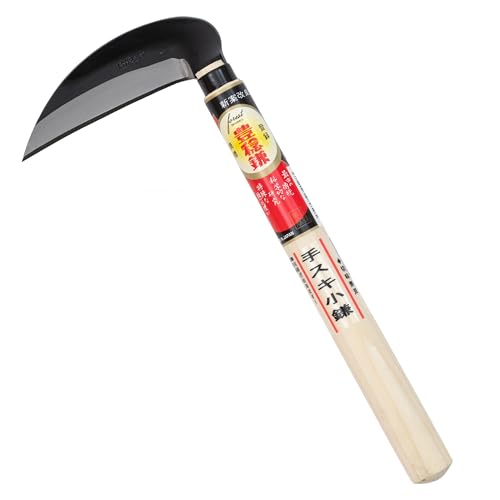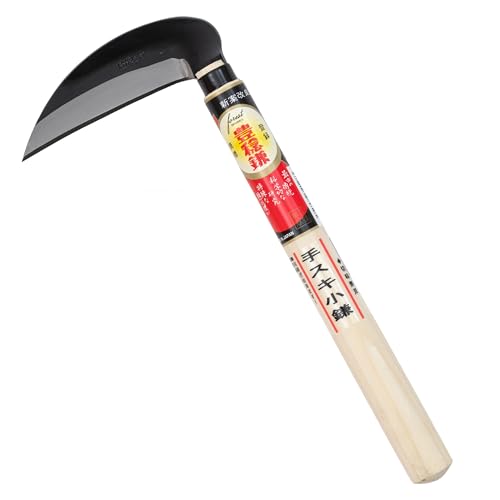Controlling weeds along forest edges is essential for healthy trees and plants. Choosing the right tool makes the job easier and more effective.
The Forest Originals Hounen Miyawaki Japanese Weeding Sickle is a great choice for clearing unwanted plants. This tool has a curved, plain-edge blade made from rust-resistant Japanese steel. Its lightweight wooden handle provides a comfortable grip, allowing you to work longer without strain.
The design helps you cut weeds close to the ground, protecting nearby trees and shrubs. Made in Japan, this sickle combines traditional craftsmanship with modern quality. Using the right weeding tool keeps forest edges neat and supports better growth for native plants. Simple, durable, and efficient – this sickle suits both beginners and experienced gardeners.
Forest Originals Hounen Miyawaki Japanese Weeding Sickle (kama)

The forest Originals Hounen Miyawaki Japanese Weeding Sickle (Kama) is ideal for avid gardeners, landscapers, and outdoor enthusiasts who require a reliable and precise tool for weeding and trimming. If you value craftsmanship, durability, and efficient performance in your gardening tools, this sickle is a perfect choice for you. Its design suits those who appreciate traditional Japanese steel tools combined with modern functionality.
Pros:
- Curved plain-edge blade designed for smooth and efficient cutting.
- Made from rust-resistant Japanese steel ensuring long-lasting sharpness and durability.
- Lightweight wood handle that provides excellent grip and reduces hand fatigue during extended use.
- Non-twisted blade enhances precision and control for detailed gardening tasks.
- Compact dimensions (Height: 1.2 inches, Width: 4.72 inches, Length: 10.63 inches) for easy maneuverability and storage.
- Authentically made in Japan, guaranteeing superior craftsmanship.
Cons:
- May require regular maintenance to keep the blade sharp over time.
- Not ideal for heavy-duty chopping or cutting thick branches.
- Natural wood handle might need occasional oiling to maintain its condition.
The forest Originals Hounen Miyawaki Weeding Sickle features a beautifully curved plain-edge blade crafted from rust-resistant Japanese steel. This material not only resists corrosion but also ensures the blade maintains its sharpness, allowing users to efficiently remove weeds and perform precise cuts. The non-twisted design of the blade provides enhanced control, making it easier to navigate tight spaces and delicate plants without damage.
Its lightweight wood handle offers a comfortable grip that minimizes hand strain during prolonged gardening sessions. The natural aesthetics of the handle combined with its ergonomic design highlight the balance between traditional craftsmanship and practical usability. Additionally, the compact size and careful construction make this sickle a versatile tool for various gardening tasks, whether you are tending to flower beds, vegetable patches, or intricate landscaping projects.
To buy this product, click here.
Frequently Asked Questions
What Makes The Hounen Miyawaki Weeding Sickle Ideal For Forest Edges?
The Hounen Miyawaki sickle features a curved, plain-edge blade perfect for precise weed control. Its rust-resistant Japanese steel ensures durability. The lightweight wood handle offers comfortable use, making it ideal for managing dense weeds along forest edges efficiently.
How Does The Non-twisted Blade Improve Weeding Performance?
The non-twisted blade design allows better control and cleaner cuts. This reduces strain and increases accuracy when removing weeds. It helps maintain the blade’s sharpness longer, making it effective for repetitive use in tough forest edge conditions.
Is The Hounen Miyawaki Sickle Easy To Handle?
Yes, it has a lightweight wooden handle designed for comfort. The ergonomic design reduces hand fatigue during extended weeding sessions. Its balance enhances maneuverability, making it easier to clear weeds along forest edges safely and efficiently.
Can This Sickle Resist Rust In Outdoor Environments?
Absolutely, the blade is made from rust-resistant Japanese steel. This quality ensures longevity even in humid or wet forest edge conditions. Proper cleaning and drying after use will further maintain its rust resistance and sharpness.
Why Choose A Japanese-style Sickle For Weed Control?
Japanese sickles like the Hounen Miyawaki offer superior craftsmanship and sharpness. Their curved blades provide precise cutting, ideal for dense and uneven forest edges. This traditional design combines efficiency with durability for effective weed management.
What Maintenance Is Required For The Hounen Miyawaki Sickle?
Regular cleaning and drying after use prevent rust. Sharpen the blade periodically to maintain cutting efficiency. Store it in a dry place and oil the blade occasionally to protect the steel. Proper care extends the sickle’s lifespan and performance.
Conclusion
Controlling weeds at forest edges helps protect native plants and keeps the area healthy. Using the right tools, like the Forest Originals Hounen Miyawaki Japanese Weeding Sickle, makes this work easier and safer. Its sharp, curved blade cuts weeds cleanly without harming nearby trees.
The rust-resistant steel and lightweight handle help you work longer without getting tired. Regular weeding stops harmful plants from spreading and lets young trees grow strong. Taking care of forest edges also supports wildlife habitats and prevents soil erosion. Simple, effective tools and steady effort make a big difference over time.
Remember, consistent weed control keeps your forest edges neat and thriving. Choose tools that feel comfortable and last long. This way, your forest edges stay beautiful and healthy for years to come.

